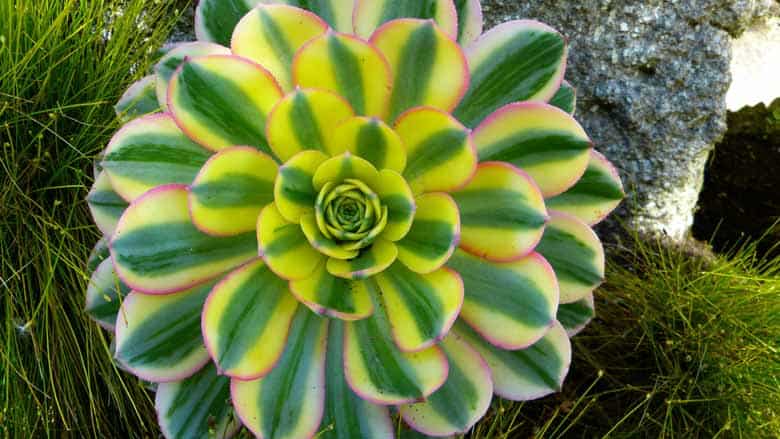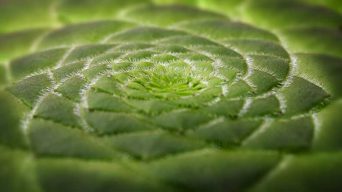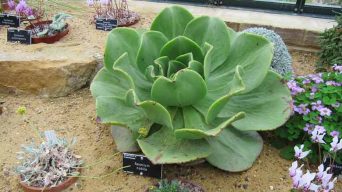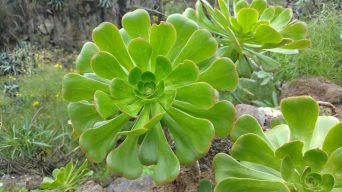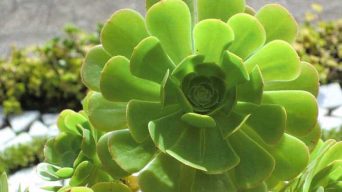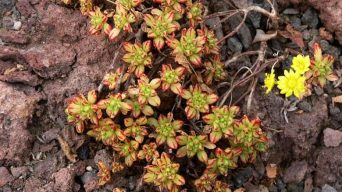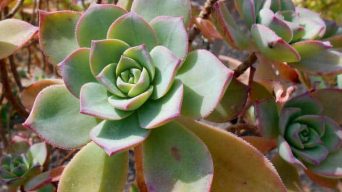The Aeonium Sunburst succulent plant is a beautiful and unique addition to any garden.
It’s easy to take care of, but there are some essential things you need to know for it to thrive.
In this guide, you will find all the information about how to care for your Aeonium Sunburst succulent plant and tips on how to propagate it successfully.
Overview
| Family: | Crassulaceae |
| Genus: | Aeonium |
| Botanical Name: | Aeonium Sunburst |
| Synonyms: | Aeonium arboreum f. luteovariegatum, Aeonium cv. Tricolor, Aeonium decorum cv. Sunburst, Aeonium decorum cv. Tricolor |
| Common Names: | Copper Pinwheel, Tree Aeonium, Tree Houseleek |
| Origin: | Canary Islands |
| USDA Hardiness Zones: | 9 – 11 |
| Size: | 18 to 24″ (45-60 cm) tall and 24″ wide (61cm) |
| Sun Exposure: | Full sun to partial shade |
| Water Needs: | Water thoroughly but infrequently |
| Soil Type: | Well-draining soil |
| Temperature: | 40°F to 100°F (4°- 38 °C) |
| Humidity Levels: | 40-60% |
Aeonium ‘Sunburst’ is a plant in the Crassulaceae family. It is an evergreen succulent plant found native to the Canary Islands.
The Sunburst Aeonium species has light yellow leaves that are green in the center. The large rosettes blush with pink around the edges when given enough light.
The large rosettes rest on long, gray stems about a half-inch in diameter.
This succulent plant can grow up to 18-24″ (45-60 cm) tall and 24″ wide (61cm).
The Aeonium produces star-shaped flowers that are pale yellow.
The Aeonium Sunburst succulent is a monocarpic plant that dies after flowering. However, it usually takes several years before blooming.
Other common names for the Aeonium Sunburst are:
- Copper Pinwheel
- Tree Aeonium
- Tree Houseleek
How To Care for Aeonium ‘Sunburst’
Aeonium Sunburst care can be tricky to master, but with this guide, you’ll have the basics down in no time.
Sun Exposure & Light Requirements
The Aeonium Sunburst plant is a succulent plant that requires bright indirect light.
It needs sunlight for at least six hours per day but prefers full sun to partial shade.
The best exposure for the Aeonium Sunburst is to be outside or near an east-facing window with plenty of direct sunlight. This gives them a chance to grow their most vivid colors.
Watering Requirements
Aeonium Sunburst succulents require a moderate amount of water.
Water the plant deeply and infrequently, allowing the top inch or two to dry between watering events.
Drench the pot with water and let it drain thoroughly before applying more.
Water should never be allowed to collect in the rosette of leaves or the base of the plant because this can promote rot and cause damage from too much weight.
The plant is sensitive to overwatering, so it mustn’t be waterlogged at any time.
The plant will need less frequent irrigation during winter when days are shorter and temperatures are lower than average.
Soil Requirements
Aeoniums need a soil that is rich in organic matter.
They prefer to be planted into well-drained soil, with high amounts of sand and peat moss mixed with the regular potting mix.
You can purchase this medium or make your own by combining equal parts peat moss, perlite, vermiculite, and coarse sand.
You want to ensure good drainage for these plants because they are susceptible to root rot if their roots stay too wet.
If you have heavy clay soils or soils that retain a lot of water, the chances could be better for success. It’s best to use something else, like a cactus or succulent mix, as an alternative.
Temperature and Humidity
The average home will find that aeonium sunburst plants are not very fussy about their temperature or humidity requirements.
They can be grown in temperatures ranging from 40°F (4 °C) to 100°F (or 38 °C).
Generally speaking, you should avoid dropping below 50-55°F because this may slow the plant’s growth and cause it to get leggy.
Regarding humidity, they like the same range of relative humidities that most other indoor plants prefer.
They will do well in a house with humidity levels between 40% and 60%.
Fertilizing
Fertilizing aeonium sunburst succulents is vital because it helps plants grow and stay healthy.
The best time to fertilize an aeonium is during its growing season. Generally speaking, most succulents need fertilizer every month when they’re actively growing so that their roots can absorb nutrients efficiently.
You should use half-strength balanced fertilizer diluted with water and applied to the soil.
Alternatively, fertilizers can be used as a top dressing for the plants.
Fertilizing with compost or manure is an alternative to using an effective and inexpensive fertilizer.
You should apply it every month during active growth periods but ensure you don’t use too much because this will lead to root rot if not done correctly.
Potting and Repotting
The first step of caring for an Aeonium Sunburst succulent is potting it.
- Place the soil in your container and lay the plant on top, with its root ball at the bottom.
- Gently press down around it so that all air pockets are removed between the roots and soil – this will allow for better water drainage and prevent rot.
- Add or remove more soil until you have enough depth to cover 75% of the surface area without any excess spillage over into neighboring pots.
Repotting Aeonium Sunburst plants should be done whenever their growth requires them to grow outside their current planter’s size.
Every year or when necessary, whatever comes first. If they start to grow in size but then stop, it is a sign that the plant needs more space.
When repotting succulents, you should aim to change their soil every two to three years. This will keep them healthy and happy with lots of new growth!
Pruning
If you want to promote Aeonium Sunburst growth, then pruning is the only way.
Removing dead or dying leaves from your Aeonium plant will help it grow in height and width.
When trimming, ensure you cut away any brown edges and don’t allow them to stay on the plant. They may remain wet and provide an ideal environment for bacteria growth.
It is essential to make sure that you don’t trim off too many leaves. The Aeonium Sunburst plant needs a certain amount of foliage to maintain moisture levels.
The best time for pruning is during spring or fall when fewer new shoots are sprouting from your succulents.
Pests and Diseases
The Aeonium Sunburst succulent is susceptible to a wide range of pests and diseases that can be difficult to control.
Pests include aphids, mealybugs, and scale insects.
Aphids are a common pest of this plant and can be controlled by using insecticidal soap to blast them off the plant.
Mealybugs and scale insects, however, need more drastic treatments such as spraying with horticultural oil or carefully scraping them away from the leaves with a toothpick.
Diseases may also occur as opportunistic plant infections weakened by other factors such as drought or poorly drained soil.
One disease that can affect the Aeonium Sunburst is powdery mildew, identified by a white or gray fuzzy growth on plant leaves.
Another common infection of this succulent is black rot, where some parts of the leaf will turn brown and curl up while others remain green.
The best way to control these diseases is to prevent them by using well-drained soil, watering only when the plant is dry, and giving it plenty of sun.
How to Care for Aeonium ‘Sunburst’ in Winter
The Aeonium Sunburst succulent plant does not require a lot of care, but there are some steps you can take to help it grow and thrive.
Here’s what you need to know about caring for your ‘Sunburst’ in winter:
- Avoid watering too often or too infrequently.
- Protect from frost (they’re sensitive) by covering them entirely with mulch/plastic sheeting.
- If grown indoors, provide plenty of bright light without direct sun exposure.
- Provide protection from drafts.
- Protect from pests and diseases with organic sprays or neem oil spray.
- Ensure proper drainage (as needed) by adding sand, gravel, perlite, and pebbles as a mulch layer. This will help prevent root rot.
Follow these simple tips for winter care of your Aeonium Sunburst succulent. It should have no problem thriving in the cold months ahead!
How To Propagate Aeonium ‘Sunburst’
Aeonium Sunburst propagation can be done by taking cuttings.
Growing Aeonium Sunburst from a cutting is easy, but there are some tricks to help ensure your project’s success.
- Cut a healthy, non-flowering Aeonium off the original plant using sharp garden shears to cut it straight across the stem down its middle for best results.
- Allow for time to let the wound heal before planting so there is less chance it will get infected.
- Plant the cutting in a well-draining potting mix.
- The planting medium should be light and airy because Aeoniums need oxygen for healthy root growth.
- Keep it in an area that gets bright, indirect sunlight to avoid scorching or wilting from lack of sun exposure, as this can cause severe damage to the plant’s foliage.
Aeonium Sunburst propagation is easy with these tips!
When propagating a succulent like Aeonium’ Sunburst’ using cuttings, always use sharp garden shears instead of a clean knife.
This ensures that you don’t accidentally slice through vital veins within the stem, inhibiting its ability to grow roots or leaves later.
Is the Aeonium Sunburst Toxic?
The Aeonium Sunburst is not a toxic succulent plant.
However, sometimes a plant may have an irritant if someone touches the sap on its skin with bare hands.
This is why wearing gloves when handling the plant is highly recommended.
Final Thoughts
The Aeonium Sunburst is an excellent plant for beginners.
The care level of the Aeonium Sunburst succulent is low, so even beginners should do well with the upkeep required by these plants!
It’s also easy to propagate and grow new plants to start a collection for your succulent garden!
The Aeonium Sunburst is a succulent that should be on your list of plants to grow if you want something low-maintenance and easy to propagate!

